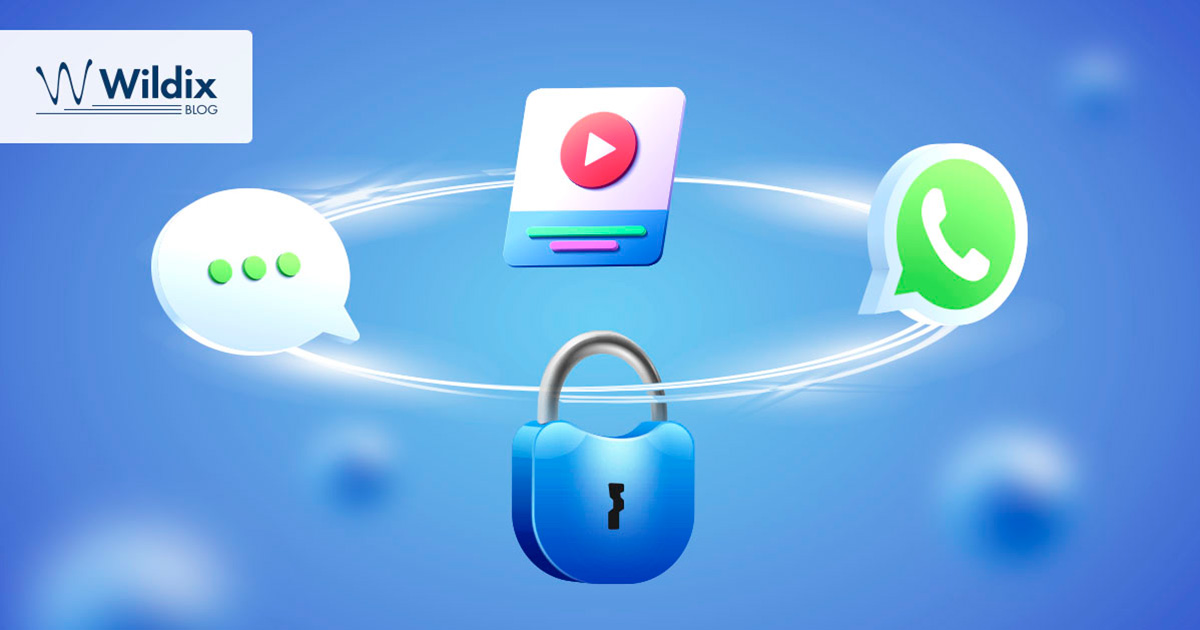
Security in business today more and more means securing the collaboration tool used at your organization. Now that we’re into the internet age, it’s just standard to conduct official communications over the web. That’s opened up the door to a lot more flexibility in terms of how we communicate, of course, including a range of possibilities for remote and hybrid work environments.
However, without a fully secure collaboration platform, communicating over the internet also opens the door to countless security problems. In particular, organizations now face the risk of cyberattacks: instances where, whether through stolen login credentials or exploiting poorly secured collaboration software, hackers steal confidential intel or severely interrupt work operations.
And with news feeds always full of reports about password breaches, interrupted video conferences and plenty more attacks, it’s easy to see the impact of these threats. Beyond the immediate financial damage, using less-than-secure enterprise collaboration tools also risks a severe blow to reputation. Amid these dire consequences, it’s absolutely critical to use the most secure collaboration tool possible whenever you communicate online.
The trouble is, with the sheer load of attacks carried out and the staggering number of vulnerabilities out there, it’s often hard to tell what secure team collaboration even looks like. What kind of technology do secure online collaboration tools even use? How much maintenance and upkeep is needed to keep them running at their best?
To answer those questions, here we’ll examine what principles to look for in secure enterprise collaboration tools. Better yet, we’ll show how to do it all with minimal training and oversight from IT departments.
Use Encrypted Collaboration Tools
First and foremost, there’s no overstating the importance of encrypting your collaboration tools. And because this has to be done at every level of your organization, encryption for collaboration tools must be a standard part of the system.

For the uninitiated, encryption in IT is a way of coding data exchanged over the internet. Not unlike wartime communications, the encryption process scrambles chat text, voice calls, video conferences and other messaging to the point that even if it were intercepted, it would be unreadable to hackers.
Of course, some ways of encrypting collaboration tools stand out above others. One of the most essential is Secure Real-Time Protocol (SRTP), which encodes data into a more complicated 160-bit result using a unique privately shared key.
But to fully encrypt your collaboration tools, more methods are better. Another protocol to use alongside SRTP is Transport Layer Security (TLS), a standard that likewise encodes data via a private key. Important in this process is that both parties meet at a TLS server, where they are not only given the decryption key, they also receive digital certifications to verify their identities to each other.
Used together, SRTP and TLS make data far more secure during exchanges. And because this combination is so important for security, a fully encrypted collaboration tool should have these protocols on by default. After all, if users can switch this off as they like — or if your software can be installed without it on — it raises the possibility that information can be intercepted and stolen.
Note, however, that TLS has seen updates over the years, and older versions of it are not secure. When considering how encrypted a collaboration tool is, be sure to check if it supports TLS 1.2 or above, as versions 1.0 and 1.1 are no longer effective.
Enforce Certificate-Based Authentication

However, hackers have more up their sleeves than quietly stealing data and running off with it. Plenty of cyberattackers work by intercepting exchanged information, then using the data to fake their identity. This is what’s known as a “man-in-the-middle” attack: when a hacker lurks in the middle of a data exchange and deletes, alters or reuses intercepted data to create havoc.
This threat is exactly why encrypted collaboration tools must also feature certificate-based authentication. Here, a trusted server (called a “certificate authority”) verifies that a user is who they say they are, then encodes their web traffic and messages with a digital “certificate” as proof of that identity. Afterwards, any communications from that user can be verified as authentic.
The good news is that TLS serves this exact function. On top of encrypting collaboration tools, TLS also includes this certificate-based authentication process in its data exchange. Although it’s not the only way to enforce digital certificates, the fact that it adds that protection on top of encryption makes it essential to look for in a secure collaboration platform.
Regardless, this protocol is crucial because it is incredibly difficult to falsify a digital certificate. To fully prevent lurking threats from doing harm, any encrypted collaboration tool must make use of certificate-based authentication in data exchanges, whether that’s through TLS or a similar standard.
Don’t Rely on External Connections
One of the biggest obstacles to security in collaboration tools is that, no matter how much IT and security training employees are given, at least a few will still ignore proper procedure. That will inevitably mean creating simple passwords, using shortcuts instead of secure connections or otherwise not following cybersecurity protocols — all of which endanger your entire organization.
The frustrating fact is, convenience has a habit of taking precedence over security. And since that makes securing your collaboration tool much harder, the solution is to not rely on inconvenient elements — in particular, external security measures.
One of the measures to avoid here are virtual private networks (VPNs). A common way to secure online collaboration tools, VPNs create a sort of tunnel within connections that’s harder for hackers to penetrate. However, VPNs can be slow to connect to and will always require a few extra steps of logging in to access. Plenty of VPNs can even slow down connections, as the signal needs to be bounced between multiple servers.
With these obstacles, it’s easy to imagine at least a few employees won’t be onboard with VPNs. Even if the company server requires a VPN to connect to it, some staff could easily look for a workaround or, worse, not connect to the main server at all. As a result, any organizations relying on a VPN will end up with a poorly secured collaboration tool.
Similarly, some organizations secure their collaboration platform using firewalls in their routers or external session border controllers (SBCs). Although both firewalls and SBCs can be useful in securing online collaboration tools, it’s critical that both function only as part of that security, not the main form of protection. After all, if an employee works outside of the office setup, or if that router and SBC configuration is otherwise altered, that protection is effectively lost.
Simply put, using additional outside elements to secure your collaboration tool will add complications and hamper ease of use. To get ahead of users who put convenience above all else, look for a system that provides security without relying on external components.
Enforce Secure Logins
Speaking of enforcing best practices, a huge part of securing enterprise collaboration tools is ensuring users don’t take too easy of an approach when it comes to creating passwords. There’s a reason that most websites require a password to have different capitalizations, numbers and special characters: the added variation makes it significantly harder for a hacker to guess those login credentials.
All secure collaboration tools have to follow the exact same principle. When creating a new profile, users should be required by the system to create a sufficiently varied password — too few characters or not enough variation, and the system must tell them to try again. Without this enforcement built into the system, organizations risk leaving an obvious entry point wide open to hackers.
Likewise essential to security at this initial stage is the use of 2-factor authentication (2FA). Like the name implies, this protocol requires users to provide a second form of verification after they enter the correct password. Usually, this is done by sending a unique code to the user’s phone or email address.
This step dramatically reduces the possibility of a hacker breaking into a profile, as to do so they’d need both the password and the unique code. As such, it’s important that admins have the option to require 2FA to secure their collaboration platform.
However, all these steps still have a gaping problem: users will still have to remember the complicated password they created (or else save it or write it down, where it can potentially be stolen). Not to mention, if some users will always take the most convenient approach to logins, isn’t it possible that they’ll find a way around these requirements?
The answer to this problem comes in the option of Single Sign-on (SSO). Through this method, users can sign into a trusted third-party platform, such as Google or Outlook, then use that successful login to access their account. Since this process requires users to log into an existing account rather than a new one, they only have to remember an old password, cutting down on the complications of accessing their communication tools.
Bottom line, it’s important that a secure team collaboration platform requires that users be safe in how they log in. Better still is if the platform strikes a balance between security and convenience, such as through SSO.
Use the Cloud for Instant Updates
Critical to the cybersecurity for any system is getting regular fixes. No matter how secure any piece of software is, hackers are always able to find some new exploit in it. As such, any secure collaboration tool must be constantly updated in response.
The problem is, if these updates don’t reach your individual system, then you still face the possibility of being hacked. Even the time spent downloading and applying the patch can be a hazard, as during that period you’re not totally secure.

One of the easiest ways to address this is to simply connect your collaboration platform to the cloud. Through a cloud setup, your collaboration tools don’t exist on an individual server. Instead, they’re on a shared server managed by your systems administrator. As a result, the latest security for the collaboration tool arrives and gets patched in instantly.
The chances of being hacked because of a slow update may seem like a remote possibility, but remember that for full security, enterprise collaboration tools should have as few vulnerabilities as possible. For reliable protection and simple peace of mind, your system should be structured to receive and apply updates as quickly as possible.
Secure Systems, Not Just Practices
At all stages of security in collaboration tools, the most important thing is to consider how the system enforces the protocols on its own — not relying on external add-ons or users’ common sense.
As important as it is that staff be kept aware of major security threats and common forms of fraud, most employees don’t have the expertise or patience to be responsible for enforcing security. To be fully reliable, a secure collaboration tool has to feature security practices enforced as part of its inherent design.
This approach is exactly how Wildix handles security. With built-in TLS and SRTP encryption, plus additional security provided by WebRTC technology, Wildix is a fully secure collaboration tool directly through its design — without the need for external VPNs, SBCs or firewalls. Learn more about how Wildix handles security through our online documentation or in our free white paper.
With how complicated it is to secure enterprise collaboration tools at any scale, it’s pivotal to always be aware of how the system itself handles threats. When considering your communication system, make sure to evaluate how it approaches this issue on its own — not just in terms of how you can make it more secure on your end.
For more tips on cybersecurity, subscribe to receive our magazine for free!